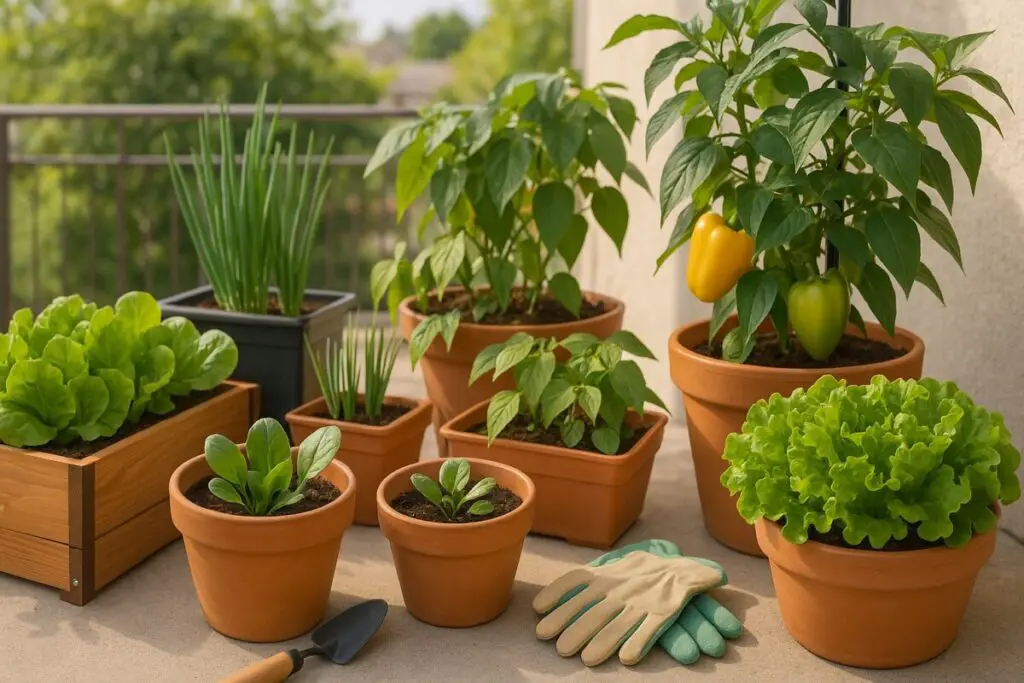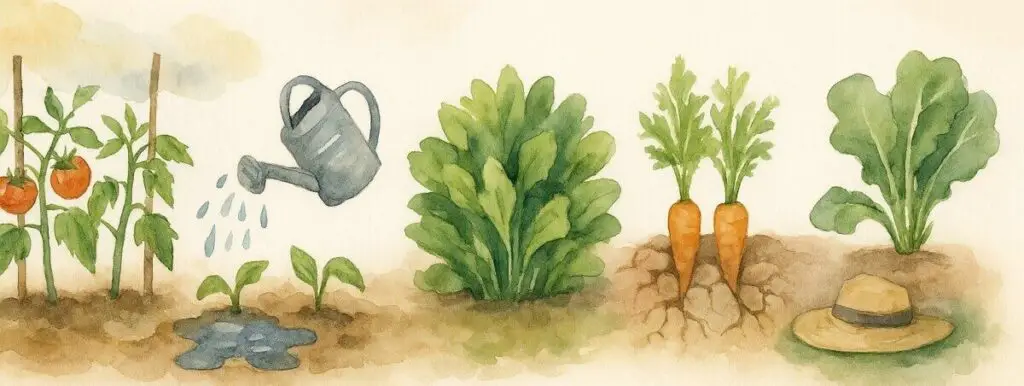
Introduction
Imagine stepping outside and plucking fresh, homegrown vegetables straight from your garden—no grocery store trip required. Even if you’re short on space or have never planted a seed before, growing your own food is easier than you think. The secret? Choosing the right vegetables.
For beginners, success in gardening comes down to low-maintenance, high-yield plants that thrive with minimal effort. Whether you have a backyard, a balcony, or just a sunny windowsill, there are plenty of options that don’t require expert-level care. In this guide, we’ll break down the 10 easiest vegetables to grow, even in the tightest spaces. You’ll also discover smart small-space gardening tricks and essential beginner tips to maximize your harvest.
Ready to turn your thumb green? Let’s dig in.
What Makes a Vegetable “Easy to Grow”?
Not all vegetables are created equal—at least when it comes to ease of growing. Some require constant pruning, pest control, or precise watering schedules, while others practically take care of themselves. For beginners, the best vegetables are low-maintenance, resilient, and adaptable. Here’s what makes a vegetable ideal for first-time gardeners:
1. Fast Growth & High Yield
The faster you see results, the more rewarding the gardening experience. Crops like radishes, lettuce, and bush beans mature quickly, giving you a harvest within weeks rather than months.
2. Tolerant of Different Conditions
Some plants are finicky about soil type, temperature, and moisture. The easiest vegetables to grow can handle imperfect conditions—from fluctuating weather to compacted soil. Leafy greens, carrots, and green onions thrive in various environments.
3. Minimal Pest & Disease Issues
Pests and plant diseases can be frustrating for beginners. Choosing vegetables that are naturally resistant to common garden threats—like zucchini, peppers, and cucumbers—makes the growing process smoother.
4. Suitable for Small Spaces & Containers
Not everyone has a sprawling backyard, but that doesn’t mean you can’t grow food. Tomatoes, spinach, and bush beans flourish in containers, raised beds, and even vertical gardens.
By focusing on vegetables with these qualities, you’ll set yourself up for a stress-free, high-reward gardening experience. Now, let’s explore the top 10 easiest vegetables that fit the bill!
The 10 Easiest Vegetables for Beginners
If you’re new to gardening, choosing the right vegetables can make all the difference between frustration and a thriving, productive garden. These 10 beginner-friendly vegetables grow quickly, require minimal maintenance, and thrive in small spaces—even in containers or raised beds.
1. Lettuce & Leafy Greens
- Why it’s easy: Fast-growing, cut-and-come-again harvesting.
- Best for: Containers, raised beds, or small garden patches.
- Growing tip: Keep soil consistently moist and harvest outer leaves regularly to encourage continuous growth.
2. Radishes
- Why it’s easy: Grows in as little as 3-4 weeks with minimal care.
- Best for: Small garden beds, containers, or even window boxes.
- Growing tip: Plant radishes in loose soil for proper root development and replant every few weeks for a continuous supply.
3. Green Onions
- Why it’s easy: Can be grown from store-bought onion scraps.
- Best for: Containers, garden beds, or hydroponic setups.
- Growing tip: Simply plant onion bulbs in soil or water, and they’ll regrow quickly.
4. Cherry Tomatoes
- Why it’s easy: Hardy, prolific, and ideal for small spaces.
- Best for: Hanging baskets, patio containers, or trellises.
- Growing tip: Provide support with stakes or cages and prune excess leaves for better airflow and fruit production.
5. Spinach
- Why it’s easy: Grows well in cooler weather and shady spots.
- Best for: Containers, raised beds, or even indoor pots.
- Growing tip: Harvest leaves frequently to encourage continuous growth before the plant bolts (flowers).
6. Carrots
- Why it’s easy: Low maintenance, just requires loose soil for root development.
- Best for: Deep containers or garden beds with soft, sandy soil.
- Growing tip: Thin seedlings early to give carrots space to grow straight and strong.
7. Zucchini
- Why it’s easy: Extremely high-yielding and resistant to most pests.
- Best for: Raised beds or large containers.
- Growing tip: Give them plenty of room to spread, or train them to grow vertically with a trellis.
8. Peppers (Bell & Hot)
- Why it’s easy: Hardy plants with high resistance to pests and diseases.
- Best for: Pots, balconies, or raised garden beds.
- Growing tip: Peppers love heat—keep them in a sunny spot and avoid overwatering.
9. Bush Beans
- Why it’s easy: No trellis required, grows fast, and produces continuously.
- Best for: Containers, garden beds, or balcony gardens.
- Growing tip: Pick beans frequently to encourage more production throughout the season.
10. Cucumbers
- Why it’s easy: Fast-growing and thrives in vertical gardens.
- Best for: Hanging baskets, trellises, or garden beds.
- Growing tip: Train vines up a trellis to save space and keep cucumbers clean and straight.
By starting with these beginner-friendly vegetables, you’ll enjoy quick rewards, minimal upkeep, and fresh homegrown produce in no time. Next, let’s explore how to maximize small spaces for even bigger harvests!
Maximizing Small Spaces: Smart Gardening Strategies
Just because you’re short on space doesn’t mean you have to limit your harvest. With the right strategies, you can grow an abundance of fresh vegetables—even in the tiniest of areas. Here’s how to make the most of your available space:
1. Use Vertical Gardening Techniques
If you don’t have a large garden bed, think upward instead of outward. Many vegetables—like tomatoes, cucumbers, and beans—thrive on trellises, stakes, or hanging baskets. This not only saves space but also improves air circulation and reduces disease risks.
- Best plants for vertical gardening: Cucumbers, peas, tomatoes, pole beans, and zucchini.
- Pro tip: Use sturdy cages or wall-mounted planters to optimize limited ground space.
2. Grow in Containers and Raised Beds
Containers allow you to garden on patios, balconies, and even indoors. They offer better soil control, easier maintenance, and mobility for adjusting sunlight exposure. Raised beds are another great option, helping maximize yield in a compact space.
- Best vegetables for containers: Peppers, lettuce, carrots, cherry tomatoes, and radishes.
- Pro tip: Choose containers with good drainage and use a high-quality potting mix to promote strong root development.
3. Practice Succession Planting
Want a continuous harvest instead of everything ripening at once? Succession planting means replanting crops like lettuce, spinach, and radishes every couple of weeks. This keeps your garden producing fresh food all season long.
- Best vegetables for succession planting: Leafy greens, radishes, green onions, and bush beans.
- Pro tip: Keep track of planting dates to ensure a steady supply of fresh vegetables.
4. Companion Planting for Healthier Crops
Some plants grow better when paired together, naturally repelling pests and improving growth. For example, planting basil near tomatoes enhances their flavor and keeps bugs away, while marigolds deter pests from most garden vegetables.
| Vegetables | Best Companion Plants | Why It Works |
| Tomatoes | Basil, Marigolds, Carrots | Improves flavor, repels pests |
| Cucumbers | Beans, Radishes, Dill | Deters cucumber beetles |
| Peppers | Basil, Spinach, Onions | Boosts growth, repels insects |
| Carrots | Onions, Lettuce, Chives | Prevents carrot flies |
- Pro tip: Avoid planting crops that compete for the same nutrients or attract the same pests. For example, don’t plant beans near onions, as they can stunt each other’s growth.
5. Choose Dwarf or Compact Varieties
Many vegetables come in smaller, more space-efficient varieties that are perfect for small gardens. Look for labels like “dwarf,” “patio,” or “bush” when selecting seeds or plants.
- Great compact vegetable varieties:
- Tomatoes: ‘Tiny Tim,’ ‘Patio Princess’
- Peppers: ‘Mini Bell,’ ‘Snack Pepper’
- Cucumbers: ‘Spacemaster,’ ‘Patio Snacker’
- Zucchini: ‘Bush Baby,’ ‘Astia’
By using these smart gardening techniques, you’ll get the most out of your small-space garden—producing more food with less hassle. Up next, let’s go over some beginner mistakes to avoid so you can grow with confidence!
Avoid These Common Beginner Mistakes

Starting a vegetable garden is exciting, but it’s easy to make mistakes that can stunt growth, reduce yields, or even kill plants. Avoid these common pitfalls to ensure your garden thrives from the start.
1. Overwatering or Underwatering
Watering is crucial, but many beginners either drown their plants or let them dry out too much. Different vegetables have different water needs, so it’s important to strike a balance.
- Signs of overwatering: Yellowing leaves, wilting despite wet soil, root rot.
- Signs of underwatering: Droopy plants, dry and cracked soil, slow growth.
- Pro tip: Stick your finger an inch into the soil—if it feels dry, it’s time to water. Early morning watering is best to reduce evaporation.
2. Planting Too Close Together
It’s tempting to squeeze as many plants as possible into your garden, but overcrowding reduces airflow, increases disease risk, and leads to weaker plants.
- Solution: Follow spacing guidelines on seed packets or plant tags.
- Pro tip: Use vertical gardening techniques to maximize space without overcrowding.
3. Ignoring Sunlight Requirements
Not all vegetables have the same light needs. Many beginners unknowingly plant sun-loving vegetables like tomatoes or peppers in shady areas, resulting in poor yields.
- Full sun crops (6+ hours/day): Tomatoes, peppers, cucumbers, zucchini.
- Partial shade crops (3-6 hours/day): Lettuce, spinach, radishes, carrots.
- Pro tip: Observe how sunlight moves across your garden throughout the day before planting.
4. Neglecting Soil Health
Healthy plants start with healthy soil. If your soil lacks nutrients, plants will struggle to grow, no matter how much you water them.
- Solution: Add compost or organic matter to enrich the soil.
- Pro tip: Test your soil’s pH and nutrient levels before planting to ensure optimal conditions.
5. Forgetting to Harvest on Time
Waiting too long to harvest can lead to overripe, tough, or bitter vegetables. Many crops, like lettuce and zucchini, are best when picked young.
- Solution: Check plants daily for ripe produce.
- Pro tip: For continuous harvesting, pick leafy greens and herbs frequently to encourage regrowth.
By avoiding these common mistakes, you’ll set yourself up for gardening success with healthier plants and bigger harvests. Now, let’s wrap up with some final tips to keep your garden thriving all season long!
Final Tips for a Thriving Beginner Garden
Now that you know what to grow, how to maximize space, and the mistakes to avoid, let’s wrap up with some final tips to ensure your vegetable garden thrives all season long.
1. Start Small and Expand Gradually
It’s tempting to plant everything at once, but starting with a manageable number of vegetables allows you to learn the basics without getting overwhelmed. Once you gain confidence, you can gradually expand your garden.
- Best approach: Start with 3-5 easy-to-grow vegetables and add more as you gain experience.
- Pro tip: Keep a gardening journal to track what works and what doesn’t.
2. Feed Your Plants Regularly
Vegetables are heavy feeders, meaning they need consistent nutrients to produce abundant harvests. Organic fertilizers, compost, or worm castings can keep your soil rich and your plants strong.
- Best natural fertilizers: Compost, fish emulsion, liquid seaweed, and aged manure.
- Pro tip: Feed plants every 2-4 weeks, following the recommendations for each vegetable type.
3. Keep Pests and Diseases in Check
Even beginner-friendly gardens can attract pests or suffer from diseases. Regular observation is key to catching problems early.
- Natural pest control methods:
- Plant marigolds or basil to repel insects.
- Use neem oil or insecticidal soap for infestations.
- Hand-pick larger pests like caterpillars and squash bugs.
- Pro tip: Rotate crops each season to prevent soil-borne diseases from taking hold.
4. Make Gardening a Daily Habit
A little daily attention can make all the difference in keeping your garden healthy. Check soil moisture, look for pests, and remove any weeds before they take over.
- Best daily tasks: Watering, harvesting, and quick pest checks.
- Pro tip: Spend just 10-15 minutes a day in your garden—it’s easier than trying to fix problems later.
5. Enjoy the Process and Keep Learning
Gardening is a journey, not just a destination. Every season will teach you something new, whether it’s about plant growth, weather patterns, or pest behavior.
- Pro tip: Join online gardening communities or local gardening clubs to learn from others and share your progress.
Ready to Grow? Start Your Gardening Journey Today!
By choosing the right vegetables, using smart gardening techniques, and avoiding common pitfalls, you’re well on your way to a thriving beginner garden. Whether you have a backyard, balcony, or just a few containers, you can grow fresh, delicious vegetables with ease.
Frequently Asked Questions (FAQs)
1. What is the easiest vegetable to grow for a complete beginner?
Lettuce, radishes, and green beans are among the easiest vegetables for beginners. They grow quickly, require minimal care, and can thrive in small spaces.
2. How much sunlight do vegetable plants need?
Most vegetables need at least 6 hours of direct sunlight per day. Leafy greens like spinach and lettuce can tolerate partial shade, while fruiting vegetables like tomatoes and peppers need full sun.
3. Can I grow vegetables indoors or on a balcony?
Yes! Many vegetables, including herbs, leafy greens, and cherry tomatoes, can grow in containers indoors or on a balcony. Just ensure they get enough sunlight or use grow lights if needed.
4. How often should I water my vegetable plants?
It depends on the vegetable and weather conditions, but most gardens need about 1 inch of water per week. Check soil moisture by sticking your finger an inch deep—if it feels dry, it’s time to water.
5. What’s the best soil for growing vegetables?
Rich, well-draining soil with plenty of organic matter is ideal. A mix of compost, garden soil, and perlite or sand helps retain moisture while preventing waterlogging.

